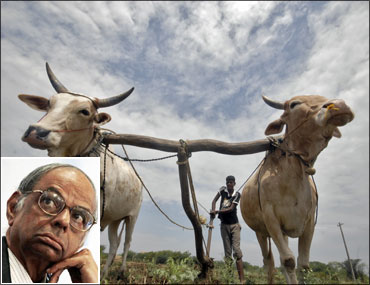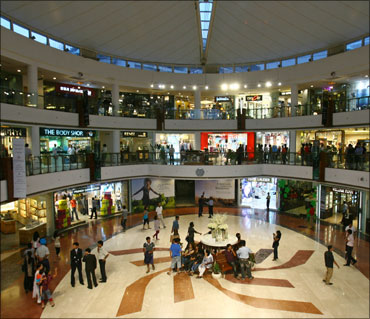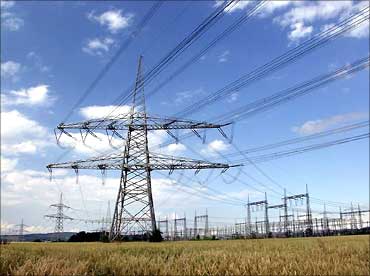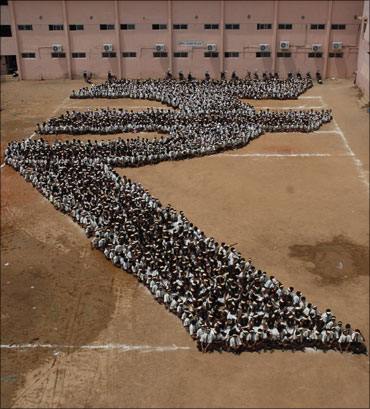
The Prime Minister's Economic Advisory Council on Friday said the economy will grow by 8.5 per cent, up from a projected 8.2 per cent, and inflation will come down from double digits to 6.5 per cent by the end of 2010-11.
The growth projection has been revised upwards on account of prospects of good monsoon, PMEAC chairman C Rangarajan said while releasing the economic outlook for the current fiscal.
It forecast a growth of 9 per cent for 2011-12.
In February, the Council had projected a growth rate of 8.2 per cent for the current fiscal.
Ahead of the RBI's monetary policy review on Tuesday, the Prime Minister's Economic Panel on Friday pitched for tightening of money supply as current inflation rate at over 10 per cent is double than the comfort level and can hurt high economic growth in the medium term.
Describing inflation as source of major concern for quite some time, the PM's Economic Advisory Council Chairman, C Rangarajan, told reporters that inflation would start coming down only by August-September and stands at 7-8 per cent in December, before declining to 6.5 per cent by this fiscal end.
He said controlling high inflation is essential for sustainable growth in the medium term.
Rangarajan said inflation is triggered by food prices. To control food inflation, he prescribed release of foodgrains through PDS in a manner to dampen these prices and continuation of import of wheat, rice and sugar on zero customs duty.
Even after a decline, food inflation stood at 12.47 per cent during the week ended June 10.
Click on NEXT to read more...

Following are the highlights of the Economic Outlook 2010-11 released by the Prime Minister's Economic Advisory Council:
Click on NEXT to read more...

The panel noted that the expansion in horticulture and animal husbandry and a low base effect should generate a farm sector GDP growth of around 4.5 per cent in the current fiscal.
It projected the sector to grow by 4 per cent in 2011-12.
"So far the indications are that the monsoon would be normal. On that assumption, we are making forecast that agriculture growth would be 4.5 per cent in the current fiscal and this comes after two years of low growth," Rangarajan told reporters in New Delhi.
In the first three years of the current Plan period, the farm sector has achieved an average annual growth of 2.16 per cent and if the PMEAC's projection for this fiscal and the next proves to be correct, then the average annual growth for the entire 11th Five-Year Plan Period would be 3 per cent.
The government had targeted 4 per cent growth in the farm sector for the current Plan Period ending March 2012.
Food and Agriculture Minister Sharad Pawar had earlier said the country was likely to have bumper production this year on the back of good monsoon.
"The latest sowing report shows that compared to last year, the area coverage is more for rice, oilseeds, pulses, cotton, sugarcane and jute," Pawar had said.
Farmers have sown paddy in an area of about 124.78 lakh hectares till July 16, against 122.40 lakh hectare in the same period last year.
India had produced 234.47 million tonnes of foodgrains in 2008-09 and 218.2 million tonnes in 2009-10 crop year.

The country would be "lucky" to add even 62,000 MW of power generation capacity by the end of the current 11th Five-Year Plan period (2007-12), much less than the targeted 78,000 MW.
Large capacities would be commissioned in 2010-11 and 2011-12, but the country is likely to fall short of the 78,740 MW target set by the government.
"In the power sector it appears we would be lucky to get 62,000 MW by March 2012," Rangarajan said
In the current fiscal, the target for capacity commissioning is 21,441 MW, of which over 6,600 MW is in the private sector, about 6,900 MW in the state sector and 7,900 MW in the central sector.
The report observed that the failure to create physical infrastructure in time has been a binding constraint on the expansion of manufacturing output, and this has been a significant contributor to lower competitiveness.
Fuel has increasingly become another limitation in the power sector and "we have to broadbase our fuel usage to encompass nuclear power, natural gas and renewable sources and reduce the proportion of coal," it said.
Click on NEXT to read more...

The panel said it is hard to visualise strong economic growth in the advanced economies in 2010 and to a large extent in 2011.
The implications of this, for India's strategy to return to the 9.0 per cent growth trajectory, are that public policy must promote business confidence and facilitate increased investment.
India's exports are projected to grow by about 22 per cent to $216 billion in the current fiscal on the back of recovery in global trade.
The PMEAC expects exports to overshoot the Commerce Ministry's target of $200 billion, which was set against $176.6 billion achieved in 2009-10. It projects merchandise exports to go further up to $254 billion in 2011-12.
Without elaborating, however, the council said the country's exports face uncertainty.
"The anecdotal evidence from export businesses on their order position and trade enquiries suggests that a stronger growth may be possible, but there is some uncertainty about this," it said.
With contraction in global merchandise demand, India's exports declined by 4.7 per cent to $176.6 billion in 2009-10.
However, in the first two months of the current fiscal exports grew by 35.7 per cent.
Global trade has seen recovery in 2010 and the outlook looks bright.